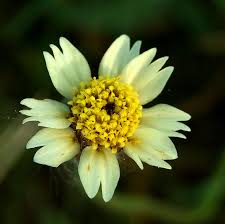Researchers Develop Herbal Method to Remove Fluoride from Drinking
Water2013 04 02
From: Organic Connections
Researchers in India have developed a filter system based on a medicinal herb, which they say can quickly and easily remove fluoride from drinking water.
 The technology
described in the March issue of the International Journal of Environmental
Engineering uses parts of the plant Tridax procumbens as a biocarbon
filter for the ion.
The technology
described in the March issue of the International Journal of Environmental
Engineering uses parts of the plant Tridax procumbens as a biocarbon
filter for the ion.
Drinking water can contain natural fluoride or fluoride might be added as a protective agent for teeth by water companies. However, its presence is not without controversy while in some natural drinking water levels may be above those considered safe by the World Health Organisation. Chemist Malairajan Singanan of the Presidency College (Autonomous), in Chennai, points out that the WHO guidelines suggest that a safe level of fluoride is 1.5 milligrams per liter.
 He adds that various techniques to reduce
fluoride content have been tried including coagulation, adsorption,
precipitation, ion exchange, reverse osmosis, and electrodialysis. However,
metal ions with an affinity for fluoride in a biocarbon matrix represent a
promising new approach.
He adds that various techniques to reduce
fluoride content have been tried including coagulation, adsorption,
precipitation, ion exchange, reverse osmosis, and electrodialysis. However,
metal ions with an affinity for fluoride in a biocarbon matrix represent a
promising new approach.
Singanan has investigated Tridax procumbens, which is commonly used as a medicinal herb in India, as a biocarbon absorbent for fluoride. Previously, the plant has been tested in the extraction of toxic heavy metals from water. He explains that by loading up plant tissue with aluminum ions it is possible create a safe biocarbon filter that will readily absorb fluoride ions from water warmed to around 27 Celsius passing through the filter.
[...]
Read the full article at: organicconnectmag.com
From Wikipedia:
From: Organic Connections
Researchers in India have developed a filter system based on a medicinal herb, which they say can quickly and easily remove fluoride from drinking water.
 The technology
described in the March issue of the International Journal of Environmental
Engineering uses parts of the plant Tridax procumbens as a biocarbon
filter for the ion.
The technology
described in the March issue of the International Journal of Environmental
Engineering uses parts of the plant Tridax procumbens as a biocarbon
filter for the ion.Drinking water can contain natural fluoride or fluoride might be added as a protective agent for teeth by water companies. However, its presence is not without controversy while in some natural drinking water levels may be above those considered safe by the World Health Organisation. Chemist Malairajan Singanan of the Presidency College (Autonomous), in Chennai, points out that the WHO guidelines suggest that a safe level of fluoride is 1.5 milligrams per liter.
 He adds that various techniques to reduce
fluoride content have been tried including coagulation, adsorption,
precipitation, ion exchange, reverse osmosis, and electrodialysis. However,
metal ions with an affinity for fluoride in a biocarbon matrix represent a
promising new approach.
He adds that various techniques to reduce
fluoride content have been tried including coagulation, adsorption,
precipitation, ion exchange, reverse osmosis, and electrodialysis. However,
metal ions with an affinity for fluoride in a biocarbon matrix represent a
promising new approach.Singanan has investigated Tridax procumbens, which is commonly used as a medicinal herb in India, as a biocarbon absorbent for fluoride. Previously, the plant has been tested in the extraction of toxic heavy metals from water. He explains that by loading up plant tissue with aluminum ions it is possible create a safe biocarbon filter that will readily absorb fluoride ions from water warmed to around 27 Celsius passing through the filter.
[...]
Read the full article at: organicconnectmag.com
From Wikipedia:
Tridax procumbens is known for several potential therapeutic activities like antiviral, anti oxidant antibiotic efficacies, wound healing activity, insecticidal and anti-inflammatory activity. Some reports from tribal areas in India state that the leaf juice can be used to cure fresh wounds, to stop bleeding, as a hair tonic. Despite these known benefits, it is still listed in the United States as a Noxious Weed and regulated under the Federal Noxious Weed Act.
No comments:
Post a Comment